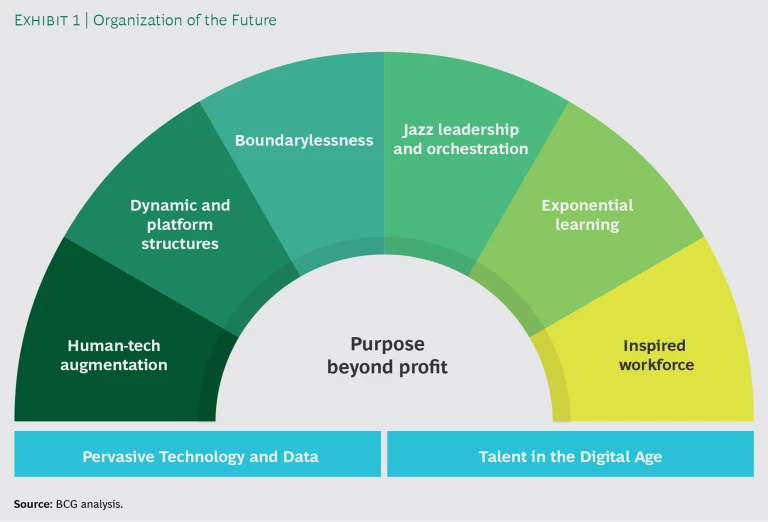The business world is changing at an exponential rate. Multiple forces are reshaping how organizations function, including new technologies, changing business needs, an evolving talent market, and greater employee expectations, among others. Most organizations are not keeping up—a Gallup study found that only 15% of employees are engaged at their jobs, and our own research has shown that productivity growth has slowed worldwide, from 5% on average in the 1970s to barely 1% today. Organizations need to find new ways to succeed in such an environment.
Tweaking around the edges of current organizational models will not be sufficient. In the past, organizations were designed for steadiness, efficiency, and predictability using strictly defined jobs, hierarchies, and organizational boundaries. As new technologies emerge and talent brings new expectations and skills, the fundamental logic of organizational mechanics that we have relied on for more than 100 years is being upended.
In order to take on these organizational assumptions, leaders need to fundamentally rethink why organizations exist and how they operate. They need to look at technology not as a way to replace manpower but as an enabler to unleash the potential of individuals and ecosystems to positively impact society. They need to unlearn the mechanistic view of organizations that has dominated for the past century and imagine the organization of the future as something that is still robust but more organic and evolving. (See Exhibit 1.) This organization will be able to leverage the shifts in technology and talent toward achieving a purpose beyond profit and beyond existing business models.
The Key Drivers of Change: Pervasive Technology and Data and Talent in the Digital Age
Every business is now a technology business. No longer can companies think of their technology function as a separate, independent, and siloed entity. Companies will need to embed technology and the requisite functional expertise across all parts of the business. Companies will no longer be simply technology-enabled; they will transform into “tech-first” entities, across industries. This is a fundamental shift that must be reflected in how leaders think about their organizations and how people and technology work together.
The workforce is changing as well. Millennials and Generation Z employees are on track to make up 59% of the workforce by 2020, according to Manpower Group. These employees have different expectations about engagement and working models—our research shows that 67% of millennials expect employers to have purpose and their jobs to have societal impact, and a Gallup study suggests that, by 2028, 73% of all teams will have remote workers. The new workforce thinks beyond traditional full-time employment and is comfortable with gig work, temping, contracting, and self-employment—potentially even simultaneously. In fact, our research shows that roughly 45% of current gig workers choose to remain independent, compared with only 20% who would prefer a full-time position. And as automation permeates the workplace, all employees will need digital skills to design, maintain, and collaborate with machines, along with distinctly human capabilities such as creativity, judgment, empathy, and imagination.
Our research shows that 67% of millennials expect employers to have purpose and their jobs to have societal impact.
In the context of these shifts, organizations need to fundamentally rethink the way they work—to leverage technology to unleash the potential of people and the ecosystems in which they operate to serve companies’ stakeholders and society overall. This will allow organizations not only to succeed commercially but also to guide the business world and society to a more positive future.
The North Star: Purpose Beyond Profit
The new generation—of both talent and consumers—expects businesses to look beyond profit and to positively impact society. Companies must shift their focus from a short-term view of total shareholder return (which measures only financial gains) to a humanistic, long-term view of total societal impact, or TSI (which measures the economic, social, and environmental impact of a company’s products, services, operations, core capabilities, and activities). Purpose, and its impact on strategy, sits at the heart of this shift. (See the sidebar “Stanley Black & Decker: An Industrial Company and Tool Manufacturer Identifies Itself as an Organization in Service to Makers.”) Companies need an authentic purpose that is grounded in humanity. A study conducted by BCG and BrightHouse found that organizations with a well-defined purpose were more likely to show above-average performance. The need for purpose points to several imperatives for companies.
Stanley Black & Decker
Stanley Black & Decker
An Industrial Company and Tool Manufacturer Identifies Itself as an Organization in Service of Makers
Stanley Black & Decker (SBD) is a global industrial leader in tools, household hardware, and engineered fastening and security products. SBD’s purpose, “For Those Who Make the World,” launched in 2017 and helped the organization home in on its role as a company in service of makers, distinguishing it as a distinctly human industrial company in a highly functional category. CEO Jim Loree captures the impact of the purpose: “We’re the largest tool company in the world, and we impact people through our tools. ‘For Those Who Make the World’ is not about us. We’re for the makers and creators, the craftsman and the caregivers—those who are out there doing the hard work every day to make the world a better place.”
Today, SBD’s purpose continues to have an impact. The company’s diverse business units have embedded the purpose and are using it to reorient the culture and inform strategic decisions. SBD also launched a purpose-driven corporate social responsibility strategy in alignment with the United Nations 2030 Sustainable Development Goals to focus on empowering makers, innovating with purpose, and creating a more sustainable world. Since the company established this purpose, revenue has increased by 20%, far exceeding the industry average.
Make purpose personal. Rather than limiting purpose to a simple statement, companies need to create experiences to help employees understand the corporate purpose at a personal level. If it directly impacts their roles and teams on a daily basis, employees will connect to the purpose emotionally and believe that they can live it and advocate for it every day.
Take meaningful stands. Consumers today not only expect businesses to share their convictions around societal issues but also demand that they take a visible stand in the marketplace. Kroger launched a social impact platform, “Zero Hunger Zero Waste,” in which the company committed to ending hunger in the communities where it operates and eliminating waste across the company by 2025. Kroger was named to Fortune magazine’s Change the World 2018 list for this effort.
Make bold decisions. Purpose must be a strategic lens that helps direct where the company should operate—or not operate—even when those decisions are discomforting. For example, pharmacy chain CVS made the bold decision in 2014 to stop selling all tobacco products, which accounted for $2 billion in annual revenue. This led to a broader focus at CVS on expanding its affordable health care services—and truly living its purpose of “helping people on their path to better health.”
Characteristics of Reimagined Organizations
To win in the ‘20s, organizations will need to focus on six attributes that will allow them to adapt and thrive. Organizations with these attributes will be able to innovate more quickly, develop deeper and more personalized relationships with customers, and unleash the combined power of humans and technology.
Human-Tech Augmentation
Most technology discussions focus heavily on the human implications of automation—specifically, the number of jobs it will replace. However, leveraging technology just to replace employees is a limiting concept for the future. Organizations will need to shape how people and technology work together, in order to leverage their unique strengths and unlock the potential on both sides.
Don’t just automate—refocus and reimagine. Companies are implementing automation to increase productivity, reduce errors, and improve the quality of outputs. But they must aspire to go beyond that—to solve unanticipated problems and to allow people to focus on creativity, improvements, and reimagination. For example, at Bridgewater Associates, a US investment manager with $150 billion in assets, investment principles are codified into logic flows and trading algorithms, which are then automated to serve as decision-making robo-coaches for employees. Human intervention is used primarily to test and improve the logic flows.
In the future, companies will be able to take this even further, using human-tech collaborations to reimagine ways of working and rethink problems that were previously thought to be unsolvable. For example, researchers at MIT are uncovering ways to combine traffic data, shopping data, and human movement data with urban design models to give cities a way to synthetically test different kinds of urban plans before implementing them. This would fundamentally reshape the way urban planning is done.
Fundamentally shift and then constantly recalibrate ways of working. Success in a world where traditional operations are more human-designed than human-run requires a fundamental redesign of how work gets done. It also requires room for constant change as the boundary between humans and technology shifts. This will require a willingness to regularly rethink the organization structure and an acceleration of workforce planning cycles to keep pace with evolving work, skill, and technology needs. It will also require reskilling people on an ongoing basis, rather than on an episodic basis. And, finally, it will require overall ways of working that are more iterative, cross-functional, human-centered in design, and more reliant on decentralized decision making in empowered teams. The following sections examine various aspects of these new ways of working.
In a world where operations are more human-designed than human-run, we must fundamentally redesign the way work gets done.
Dynamic and Platform Structures
As technology quickly advances, many of the core principles of organization design will need to evolve. Today’s organizations are characterized by formal reporting hierarchies, rigid job descriptions, and processes that are often overly bureaucratic. There are clear separations among the roles of governance, monitoring, enabling, and execution. But in the reimagined organization of the future, many of these elements can be decentralized and pushed closer to the customer, allowing employees to work in tech-enabled and interconnected teams that reshape themselves in response to changing needs.
To support this shift, organizational structures will need to become far more dynamic. The right solution depends on context, but in general we anticipate a three-part platform structure. At the bottom are a modular core data layer and a technology architecture layer. Above that are end-to-end “units of work,” or core business processes. Leveraging those business processes are small, agile teams. Some of those teams will consist of employees, others of gig workers, partners, freelancers, and other types of contingent labor, allowing the company to capitalize on a broader ecosystem of talent. (See Exhibit 2.) Several aspects of this structure are worth a more detailed discussion.
Build small, agile teams wherever possible. Technology will help break the compromise between scale and customization. Companies will be able to serve individual and local needs without losing the advantages of scale when it matters. But this solution requires investing in agile platforms that can support small, nimble, and digitally connected front-line teams. These teams can work in totally new ways and be far more innovative and entrepreneurial than employees in traditional structures. They can be positioned closer to the customer, disrupting the value chain and allowing for greater personalization of products and services. They leverage and actively interact with the business and data/tech platforms. For example, Amazon patented a 3D printing mobile truck unit that would collapse manufacturing, distribution, and marketing and sales into small, nimble, cross-functional units, fundamentally disrupting the traditional work model.
Technology will help break the compromise between scale and customization.
Rethink career progress. To build dynamic and platform structures, organizations must evolve away from the outdated hierarchy of roles with rigid departments, boundaries, and reporting relationships. Instead, employees will come together in cross-functional teams to work on projects with specific business objectives. When projects end, teams may dissolve and reform in new ways to meet new objectives. In this context, career paths don’t necessarily follow a single upward line; they occupy a grid that incorporates various responsibilities, larger teams, and different types of problems. For example, at Morning Star, a California-based tomato processor with $900 million in annual sales, hierarchies, titles, and career ladders don’t exist. Instead, the primary organizing method is a web of role charters, each depicting 20 to 30 individual roles, responsibilities, deliverables, metrics, and other elements.
Go beyond structure. The success of this organizational structure will depend equally on the “human operating system” (incentives, career paths, performance management, decision rights, feedback loops, information flows, resource allocation, and more) that creates the context in which work is done and on the leaders who design and maintain that operating system. It will also depend on how well the individual organization is able to leverage its ecosystem of talent, customers, and suppliers. (See the sidebar “Ping An: A Chinese Insurance Company Transforms into a Platform Organization.”)
Ping An
Ping An
A Chinese Insurance Company Transforms into a Platform Organization
Ping An Insurance, based in Shenzhen, celebrated its 30th birthday last year. The company has grown from a traditional insurance company into an integrated financial service conglomerate with core businesses in insurance, banking, and asset management. Today, it is China’s biggest insurer. The company’s transformation began when it digitized its core business, setting up online channels to reach both customers and insurance agents, and automated its back-end processes, including underwriting and claims processing. In 2008, Ping An organized its technology component into a subsidiary, Ping An Tech, which not only built and stabilized the platform but also enabled the company to develop additional customer-facing businesses, including car-buying services, shopping loyalty programs, online medical consultations, online wealth management services, and real estate listings. These front-end businesses feed data back to the platform, to be leveraged back into the insurance business, improving marketing and making Ping An agents exceptionally productive.
The company now has more than 550 million customers—in the first quarter of 2019 alone, it added 11 million (roughly 30% of whom were sourced from its internet application users). It is the industry leader by profit and return on equity, with a market capitalization of about $230 billion. And it recently finished seventh in Forbes magazine’s Global 2000 rankings.
Boundarylessness
The traditional boundaries that define a company have blurred—customers, partners, and even employees can be both inside and outside the organization. Companies will need to embrace this way of working, managing both the opportunities and the challenges it creates.
Work for and with your customers. Customers are getting more actively involved with businesses. They care about the stands, positions, ethics, and purpose of a business. And now technology allows companies to involve customers even more deeply in the development, production, delivery, and marketing of their products and services. This goes well beyond feedback and satisfaction scores; it requires reimagining the involvement of customers in every step of the company’s work. For example, Google’s Waze unit, at the time of its acquisition for $1.1 billion, employed only about 100 people. Most of the value was in aggregation of the real-time traffic information submitted by users.
Make partnering a skill. A decade ago, most companies operated with a small number of partners, thinking that anything that was very important to the business needed to be handled internally. Today that’s no longer true, and the number of partnerships at companies has increased dramatically. Given this shift, teams across the organization need to learn how to develop and nurture partnerships with other companies—a change dictated not by senior executives but by unit managers.
Nearly 50% of millennial workers freelance, but companies are not fully capitalizing on this talent pool
Embrace the gig. Nearly 50% of millennial workers freelance, more than in any other generation, and companies are increasingly using sites like Upwork and Fiverr to tap into the gig workforce. But most companies are not capitalizing on this talent pool. Leaders need to have a clear idea of which skills they need to develop through employees and which they can buy—or rent—for their businesses. They need a future workforce plan that incorporates a fair share of contingent talent. And, most important, they need to treat the gig workforce in ways that reinforce the company’s culture, including such aspects as engagement, development, purpose, and learning. (See the sidebar “Meituan Dianping: A Chinese E-Commerce Platform Creates an Ecosystem by Rethinking Relationships.”)
Meituan Dianping
Meituan Dianping
A Chinese E-Commerce Platform Creates an Ecosystem by Rethinking Relationships
Meituan Dianping has been in business for less than a decade, but it is already the leading e-commerce platform for local services in China, with nearly $9.5 billion in annual revenue. The company created enormous value by developing a network of relationships across various products and services, starting with coupon services. Recent success comes from targeting both consumers and businesses. The company’s service offerings now include food delivery, in-store dining, hotel booking, restaurant management, food supply chain services, and more.
Rather than hiring hundreds of thousands of employees, Meituan Dianping has an ecosystem of more than 5 million active merchants that interact not only with the company but also with each other. Many of its merchant partners are also customers of the company’s business services. Meituan Dianping has created new employment opportunities for many laid-off factory workers and rural youth. Serving as delivery riders and contract sales reps, these gig economy workers help the company deliver value to its customers.
Constantly expanding into new markets can often lead to internal friction; Meituan Dianping reorganizes almost every year to mitigate this. The company runs each of its businesses differently, depending on its maturity level, and it merges businesses that are sufficiently similar. This flexibility and a focus on iteration allow Meituan Dianping to stay nimble while continually growing.
Jazz Leadership and Orchestration
Leaders will stop thinking of themselves as the controllers of hardwired organizational structures, processes, and rules. Instead, they will be more like jazz conductors, Bringing Managers Back to Work and allows them to cooperate to achieve the organization’s goals.
Inspire, don’t order. As organizations decentralize and push decision making to lower levels, leaders will no longer lead through authority (as they did in traditional, direct-reporting structures). Rather, they will influence by providing the “why” behind a specific goal, and lead by modeling the right behaviors. Microsoft CEO Satya Nadella nearly tripled the company’s stock price by inspiring the organization to change from a group of “know-it-alls” to a group of “learn-it-alls” who exhibit a mindset of growth rather than of established expertise.
Shape the context. As organizations become looser connections of people and units, leaders will be much less able to simply issue orders. Instead, they’ll need to understand how the context for employees and teams affects their performance, and how to shape that context to get the right behaviors. This will involve applying some traditional factors like compensation, performance management, and organizational structure, as well as some relatively underutilized levers like learning pathways, feedback loops, information flows, and digital “nudges,” which affect behavior in real time.
From strategic planning to budgeting to goal setting, leaders will need to employ more agile methods
Design in flexibility. Leaders will need to break away from static plans with fixed cycles and adopt a more dynamic approach that can quickly respond to changing needs of the organization and the market. From strategic planning to budgeting to goal setting, leaders will need to employ more agile methods—establishing broad guidelines but giving employees greater autonomy to react to market changes. (See the sidebar “Buurtzorg: A Dutch Nursing Organization Functions Through Small Teams and Task Forces.”)
Buurtzorg
Buurtzorg
A Dutch Nursing Organization Functions Through Small Teams and Task Forces
Buurtzorg, a neighborhood-based nursing organization headquartered in the Netherlands, has more than 10,000 employees and is active in more than 24 countries. It is structured in small, self-governing teams of nurses. Teams are given support through coaching and tools—a strong intranet and internal wiki are key—and they are responsible for all tasks and decisions. The company operates with bare minimum staff functions and only 30 headquarters employees to support the entire organization. When issues arise that require adjusting operations across several teams, a temporary task force may be convened, but it is quickly dissolved after the work is done. Nearly all innovation comes from the team level, and successes are spread through the organization via the central wiki and through coaches who span several teams. This model is extremely efficient, requiring 40% fewer hours of care per client than the industry average. High nurse satisfaction ratings have helped Buurtzorg win multiple “top employer” citations.
Exponential Learning
Organizations will Competing on the Rate of Learning, so they can lead the change instead of playing catch-up. This applies to both machines and people. Given the speed at which jobs, roles, and skills will change, organizations must “learn how to learn” at speed and scale.
Leverage self-tuning algorithms. Self-tuning enterprises apply algorithms to The Self-Tuning Enterprise. This data-backed approach allows organizations to experiment more effectively, with minimal human intervention.
Introduce the learning contract. Organizations traditionally faced a dilemma—they could either offer rich, detailed training to a small number of people, or they could offer very basic training to a larger group. As training and development become more important and organizations reskill and upskill thousands of employees more or less continuously, they will need a new approach. One approach is to use “learning contracts,” which align the learning journey of an organization with the learning intent of individuals. Companies should empower employees to design their own contracts, turn managers into learning coaches to help employees apply learning in real work, and set up performance evaluation systems in which metrics are tied to business goals and outcomes, as well as personal development.
Learn to change. Companies can no longer delegate change to a change management office or a project team. Instead, change implementation must be an always-on, everyday job for leaders. Companies need to master the science and art of driving large-scale change in their organizations, without the bureaucracy of large change programs. This shift requires a spirit of experimentation and innovation, challenging companies to “test and learn” and “fail fast.”
Inspired Workforce
The next generation of talent is looking for meaning and growth opportunities in their work. Companies must go beyond extrinsic rewards and create a culture that fulfills employees’ intrinsic needs. Companies that help employees realize their full potential will benefit from greater engagement, creativity, productivity, and commitment.
Empower employees to take ownership. When leaders show that they trust employees to operate in the best interests of the company, employees take pride and ownership in their work, spurring innovation and reducing the burden on management. Netflix’s philosophy of “people over process” encourages employees to make decisions based on what they know to be the company’s best interests, rather than on preestablished policies such as vacation time and expense tracking.
Foster community and a sense of belonging. Companies can provide tools and opportunities for employees to build meaningful relationships and foster diverse and inclusive communities through shared purpose and values. For example, GetWerkin, a tech platform that aims to create a more inclusive and diverse workplace, uses digital nudges to match mentors and mentees based on geography, calendars, and other data.
Enable employees to reach mastery. Companies can equip employees with a growth mindset and give them the intellectual freedom to How Learning Contracts Can Drive an Industrious Revolution. New technologies such as virtual-reality simulation and digital personalization can help make this happen.
Encourage employees to bring their entire selves to work. Companies can also create a flexible and safe environment for employees, encouraging self-expression, holistic well-being, and work-life harmony. Organizations benefit because this type of environment allows employees to reallocate the mental energy that would have been spent on hiding a part of themselves toward more productive uses. For example, Patagonia hosts a Child Development Center for employees’ children, and it is common to see mothers nursing their children during meetings. Parents can feel comfortable revealing that they have families and associated obligations.
The pace of change can be dizzying for many leaders, but it is not going to slow down. Organizations that don’t adapt will quickly become irrelevant. Companies need to understand the underlying trends in technology and talent and capitalize on them—instead of resisting them—to emerge stronger, more agile, and better able to respond to an ever-changing environment. The companies that do will lead our society to an exciting future, where people can reach their full potential and engage every day in meaningful work.








